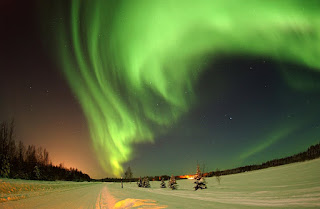If you’re on the lookout for a unique winter holiday adventure, why not go in search of the majestic and otherworldly Northern Lights, or Aurora Borealis.
Image By: pixabay free image
Northern Lights In Simple Words.
The large swivels and curtains of colorful light can only be found in the harshest of weather, but if you’re brave enough to stand the cold, this astronomical phenomenon will be more than worth it.
There’s still some mystery attached but scientists generally believe the lights occur when large numbers of electrically charged particles (electrons) “stream in towards the Earth along its magnetic field and hit with the highest air particles” at high speed. (tgo.uit.no) When the air lights up the sky, the lights have been compared to a fluorescent light tube, filled with yellows, greens and whites. A violet edge of the aurora is from the nitrogen filling the sky.
Back in the day, the Denes and other hunting civilizations used the Northern Lights to make their way through forests in the dark. They also read the lights as good or bad omens, considering unusual patterns or colors within the aurora. Many tribes and hunters believed that the lights were attracted to noise and would change or dance if whistled at.
In order to catch a glimpse of the Northern Lights for yourself, your best bet is to head to the polar regions, though some have rarely seen them in other cold places such as Canada and Siberia. The most frequent occurrences are “centered on the magnetic north pole.” (Truls Lynne Hansen, tgo.uit.no) If you stand directly under a belt of radius 2500 km, which is considered an aural zone, you’re most likely in for a treat. The zone stretches over northern Scandinavia to the southern tip of Greenland and continuing over northern Canada and Alaska, along the northern coast of Siberia. The greatest possible odds would have to be in the Norwegian counties of Troms and Finmark. Similar Southern Lights can be seen from Antarctica, Tasmania or southern New Zealand.
Both Northern and Southern Lights occur side by side each other, creating a mirror effect. Sightings are quite rare, however, so you must plan your trip carefully, guided by scientific predictions. A good site to start with is Today’s Space Weather, which will provide on the goings on edging the Earth’s atmosphere for the next few days.
Northern and Southern Lights are usually spotted only a few times a month in Toms and Finmark. If you’re game enough to brave even harsher weather north of the auroral zone, light sightings in Spitzbergen and north Norway are a very common event. The sky should be pitch black and dry in order to improve chances of spotting them.
So pack twenty layers or so of clothing and head to the poles this winter holiday in search of the beautiful world wonder people have been in awe of for centuries.

Post a Comment
If you have any doubts, Please let me know.